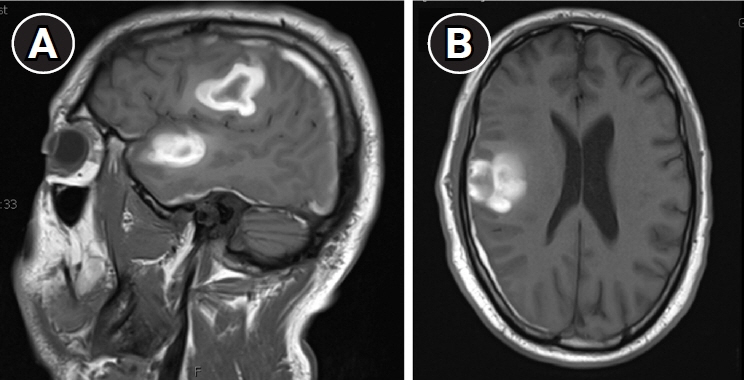J Neurocrit Care.
2024 Jun;17(1):29-33. 10.18700/jnc.240017.
Charles Bonnet syndrome following head trauma: a case report and literature review
- Affiliations
-
- 1Georgetown University School of Medicine, Washington, DC, USA
- 2Department of Neurosurgery, MedStar Georgetown University Hospital, Washington, DC, USA
- KMID: 2556731
- DOI: http://doi.org/10.18700/jnc.240017
Abstract
- Background
Charles Bonnet syndrome (CBS) is a condition characterized by vivid, complex visual hallucinations in individuals with visual impairment. Despite its prevalence among the elderly and those with degenerative eye diseases, CBS remains underdiagnosed and undertreated due to a lack of awareness and misconceptions surrounding its etiology and management.
Case Report
A 51-year-old man presented to the emergency room after falling off his bicycle without wearing a helmet. Head imaging revealed a small right frontoparietal traumatic subarachnoid hemorrhage with an associated trace subdural hematoma along the right parietal convexity. Subsequently, he developed non-light perceiving vision loss, after which he began experiencing visual hallucinations.
Conclusion
CBS is frequently overlooked or left untreated. Research on diagnosing and managing CBS following head trauma is limited. Therefore, clear diagnostic criteria for CBS and a better understanding of its underlying mechanisms are needed to improve diagnosis and management strategies.
Keyword
Figure
Reference
-
1. Schadlu AP, Schadlu R, Shepherd JB 3rd. Charles Bonnet syndrome: a review. Curr Opin Ophthalmol. 2009; 20:219–22.2. Hamedani AG, Pelak VS. The Charles Bonnet syndrome: a systematic review of diagnostic criteria. Curr Treat Options Neurol. 2019; 21:41.3. Menon GJ, Rahman I, Menon SJ, Dutton GN. Complex visual hallucinations in the visually impaired: the Charles Bonnet Syndrome. Surv Ophthalmol. 2003; 48:58–72.4. Vukicevic M, Fitzmaurice K. Butterflies and black lacy patterns: the prevalence and characteristics of Charles Bonnet hallucinations in an Australian population. Clin Exp Ophthalmol. 2008; 36:659–65.5. Tobe EH. Charles Bonnet syndrome and dementia after traumatic brain injury. Minerva Psichiatr. 2014; 55:17–23.6. Girgis S, Sethi A, Sethi S, Sethi V, Sethi R, Sethi A. Indirect traumatic optic neuropathy with associated Charles Bonnet syndrome. TNOA J Ophthalmic Sci Res. 2022; 60:186–8.7. Cebulla CM, Minning C, Pratt C, Lubow M. Charles Bonnet syndrome and Terson’s syndrome from subarachnoid hemorrhage: good news from bad news. Graefes Arch Clin Exp Ophthalmol. 2013; 251:1021–2.8. McKeith IG, Dickson DW, Lowe J, Emre M, O’Brien JT, Feldman H, et al. Diagnosis and management of dementia with Lewy bodies: third report of the DLB Consortium. Neurology. 2005; 65:1863–72.9. Lepore FE. Spontaneous visual phenomena with visual loss: 104 patients with lesions of retinal and neural afferent pathways. Neurology. 1990; 40(3 Pt 1):444–7.10. Lapid MI, Burton MC, Chang MT, Rummans TA, Cha SS, Leavitt JA, et al. Clinical phenomenology and mortality in Charles Bonnet syndrome. J Geriatr Psychiatry Neurol. 2013; 26:3–9.11. Hanyu H, Takasaki A, Sato T, Akai T, Iwamoto T. Is Charles Bonnet syndrome an early stage of dementia with Lewy bodies? J Am Geriatr Soc. 2008; 56:1763–4.12. Crumbliss KE, Taussig MJ, Jay WM. Vision rehabilitation and Charles Bonnet Syndrome. Semin Ophthalmol. 2008; 23:121–6.13. Hori H, Terao T, Shiraishi Y, Nakamura J. Treatment of Charles Bonnet syndrome with valproate. Int Clin Psychopharmacol. 2000; 15:117–9.14. Ukai S, Yamamoto M, Tanaka M, Takeda M. Treatment of typical Charles Bonnet syndrome with donepezil. Int Clin Psychopharmacol. 2004; 19:355–7.15. Bergman Y, Barak Y. Escitalopram for antipsychotic nonresponsive visual hallucinosis: eight patients suffering from Charles Bonnet syndrome. Int Psychogeriatr. 2013; 25:1433–6.
- Full Text Links
- Actions
-
Cited
- CITED
-
- Close
- Share
- Similar articles
-
- A Case of Charles Bonnet Syndrome Following Cerebral Infarction in the Right Occipital Lobe
- A Case of Charles Bonnet Syndrome After Enucleation
- Charles Bonnet Syndrome Following Bilateral Occipital Infarction
- A Case of Charles Bonnet Syndrome After Resection of a Meningioma
- Quetiapine Therapy for Visual Hallucinations Caused by Charles Bonnet Syndrome




